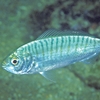General Description
Large stocky wrasses; dorsal fin single, long-based; tail large, almost square; lips thick, fleshy; scales large, heavy; teeth peg-like teeth; adults with a hump on forehead. Adult males bright blue to greenish-blue; females typically reddish-brown to brown, often with random pale spots or blotches; juveniles greyish or greyish-brown with spots or blotches. To 1.2 m long, and a weight of 18 kg.
Biology
Although most adults live around exposed coastal and offshore rocky reefs, individuals occasionally move into estuaries. Juveniles up to about 10 cm in length inhabit seagrass beds in bays and estuaries, then move to rocky reefs covered in macroalgae such as kelp. Blue gropers are benthic carnivores, feeding on a wide range of invertebrates, including crabs and other crustaceans, molluscs and echinoderms. They live in small groups or 'harems' with a large male and a number of females and juveniles. They are hermaphrodites and individuals change sex from females to males during their life cycle. Their numbers appear to be increasing in eastern Victorian and Tasmanian waters.
Habitat
Exposed coastal and offshore rocky reefs, in depths of 1-60+ m; juveniles shelter amongst seagrasses and macro-algae in bays and estuaries.
Reefs
Seagrass meadows
Distribution guide
Eastern and south-eastern Australia. In eastern Victoria, unlikely to occur west of Wilsons Promontory.
Species Group
Fishes › Wrasses, rock whitings and allies
Depth
Shallow (1-30 m)
Deep ( > 30 m)
Water Column
Max Size
1.2 m
Commercial Species
Yes
Global Dispersal
Native to Australia
Identify
Conservation Status
- DSE Advisory List : Not listed
- EPBC Act 1999 : Not listed
- IUCN Red List : Near Threatened






